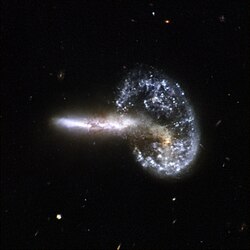Mayall's Object
| Mayall's Object | |
|---|---|
 A Hubble space telescope image of Mayall's Object | |
| Observation data | |
| Constellation | Ursa Major |
| Right ascension | 11h 03m 53.95s |
| Declination | +40° 50′ 59.90″ |
| Distance | 450 million light years |
| Other designations | |
| Arp 148, VV 032, MCG+07-23-019, APG 148 | |
Mayall's Object (also classified under the Atlas of Peculiar Galaxies as Arp 148) is the result of two colliding galaxies located 500 million light years away within the constellation of Ursa Major. It was discovered by Nicholas U. Mayall of the Lick Observatory on 13 March 1940, using the Crossley reflector.[1] When first discovered, Mayall's Object was described as a peculiar nebula, shaped like a question mark. Originally theorized to represent a galaxy reacting with the intergalactic medium[2], it is now thought to represent the collision of the two original galaxies has resulted in a new object consisting of a ring-shaped galaxy with a tail emerging from it. It is thought that the original collision between the two original galaxies created a shockwave that initially drew matter into the center which then formed the ring.[3]
References
- ^ Smith, R. T. ; The Radial Velocity of a Peculiar Nebula ; Publications of the Astronomical Society of the Pacific, Vol. 53, No. 313, p.187 Bibcode:1941PASP...53..187S
- ^ Burbidge, E. Margaret The Strange Extragalactic Systems Mayall's Object and IC 883, Astrophysical Journal, vol. 140, p1619
- ^ http://hubblesite.org/newscenter/archive/releases/2008/16/image/aa/ HubbleSite: Cosmic Collisions Galore!, April 24, 2008, accessed August 10, 2008
See also
- Ring galaxy
- Interacting galaxy
- Irregular galaxy
- Peculiar galaxy
- Mayall II, Mayall III, Mayall IV, Mayall V, Mayall VI
